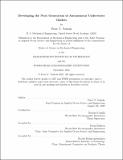Developing the Next Generation of Autonomous Underwater Gliders
Author(s)
Ventola, Peter T.
DownloadThesis PDF (27.71Mb)
Advisor
Camilli, Richard
Terms of use
Metadata
Show full item recordAbstract
This thesis presents a novel, hybrid Autonomous Underwater Glider (AUG) architecture developed for improved performance in shallow, high-current environments while maintaining all capabilities inherent to a deep, 1000m-rated AUG. Numerous regions of scientific interest, such as the marginal ice zone (MIZ) and continental shelf breaks present significant challenges to conventional AUG operations due to a combination of changing ocean currents and depths.
AUGs are traditionally optimized for performance in shallow (less than 200m) or deep water (200m to 1000m) environments. The design of a buoyancy drive on a deep-rated AUG does not support the pump rate required for fast inflections in narrow depth bands.
Contained within this thesis is the framework to expand the operational envelope of a Teledyne Webb Research (TWR) G3 Slocum glider through substantial modification of the glider's hardware components backed by rigorous hydrodynamic analysis and computational fluid dynamics (CFD) modelling. Since AUGs are limited in both speed and maneuverability, the goal of this thesis is to improve and modify the glider's flight characteristics, specifically the glider's speed through water, its inflection rate, and its efficiency. These performance improvements are accomplished through the introduction of a high-power thruster, modified wings, and aft fin surfaces. The modified glider's efficacy is evaluated through various laboratory experiments and field data obtained in Buzzards Bay and the Caribbean Sea. Design concepts for a future, more advanced glider are also discussed.
Date issued
2022-09Department
Massachusetts Institute of Technology. Department of Mechanical Engineering; Joint Program in Applied Ocean Science and EngineeringPublisher
Massachusetts Institute of Technology